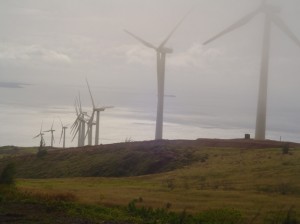Lanai Wind Farm: Agreement Reached on Power Prices and Island Benefits
By Wendy Osher
A pricing agreement has been reached on power generated by the proposed wind farm on the island of Lanai. Castle & Cooke Resorts and Hawaiian Electric Company also agreed upon proposed community benefits for Lanai residents.

The Kaheawa Wind Farm above Maalaea on Maui was the first wind generation facility permitted for construction in the county. File Photo by Wendy Osher.
The list of benefits are aimed at addressing community concerns over impacts of the wind farm on the small island and include issues pertaining to employment, hunting access and water rights.
The Interisland Wind project seeks to transmit up to 400 megawatts of electricity to Oahu via undersea cables from wind farms proposed for construction on Lanai and Molokai. The electricity generated could potentially displace about 15% of Oahu’s oil consumption.
Under the agreement, electricity prices for Lanai would be fixed for 20 years with projected “minor escalations.” Prices for Lanai targeted at about 13 cents per kilowatt-hour for a 200 MW wind farm, and 11 cents per kWh for a 500 MW facility. That’s in addition to transmission costs.
“These low prices will help protect Hawaii from the expected rise in the price of oil and reduce the risk to our economy and way of life from possible disruptions in oil supplies,” said Robbie Alm, Executive Vice President at Hawaiian Electric.
Price projections for Molokai have not yet been negotiated. The agreements are still subject to approval by the Public Utilities Commission.
The list of proposed benefits comes after three years of informal meetings and discussions. It was created to address the many issues, needs and impacts of constructing a facility on the small island of Lanai.
“These proposals can improve the economic future of Lanai while making a contribution to the state as a whole by helping reduce our dependence on imported oil. It will keep more of our energy dollars at home and protect the environment,” said Castle & Cooke Resorts president Harry Saunders.
“We will continue the dialogue with the Lanai community as we proceed with the environmental impact and permitting review processes,” said Saunders.
The proposed benefit commitments that require PUC approvals with input from the Consumer Advocate and other stakeholders are listed below:
- Electric rates for Lanai residents “levelized” to match those of Oahu. At today’s electricity costs that would reduce Lanai residential electric rates by about 40 percent while Oahu residents, with a much larger customer base, would see only minor increases.
- Lanai to be 100 percent renewable for electricity by 2030, using solar, wind, biomass and biofuel resources, as far as possible originating on Lanai.
- Grid improvements, particularly to the Manele Circuit, to allow more customer-sited distributed generation, such as roof-top photovoltaic arrays.
- Increased solar water heating with the utility paying upfront costs and being repaid through shared savings on utility bills (pay-as-you-save).
With no approvals needed from the PUC, Hawaiian Electric also commits to:
- $50,000 a year during the life of the purchase power agreement (PPA) contributed from shareholder funds to the Lanai Community Fund.
- $30,000 for at least two years from Hawaiian Electric and Maui Electric companies for community-based campaign for energy efficiency and conservation on Lanai.Castle & Cooke commits to the following, subject also to approval by the Public Utilities Commission with input from the Consumer Advocate of the purchase power agreement as well as by other stakeholders:
- Establish a Lanai Community Benefits Fund with proceeds of one percent of the wind farm’s gross revenues. Funds will be directed to economic diversification and job creation; medical and social/health services; education, training and recreation; and cultural and natural resource preservation as determined by a community committee, with at least $100,000 a year to the Lanai Cultural and Heritage Foundation.
- Employment on Lanai maintained at no lower than Castle & Cooke employment today.
- Continued access to hunting areas and if hunting must be limited to protect wind turbines, comparable acreage provided for hunting before any limits go into effect. Continued full access to coastal fishing in the Ka’a area.
- Residential, agricultural and commercial lessees to be able to buy their properties or land at fair market prices.
- Priority for qualified Lanai residents in construction jobs and contractors required to ensure that all workers respect Lanai community standards in their behavior.
- Wind generation facilities to be removed when no longer in service.
- All contractors required to protect Lanai archeological and cultural sites, monitored by Lanai residents when possible.
- 5,000 acres reserved for creating a viable biofuel crop on Lanai.
- $250,000 a year for the term of the PPA for preservation of Lanai Hale watershed.
- At least $500,000 a year for the term of the PPA for capital improvements to the Lanai water system and 250,000 gallons of water a day above the current allocation to encourage diversified agriculture.
(Supporting information courtesy HECO and Castle & Cooke Resorts)










